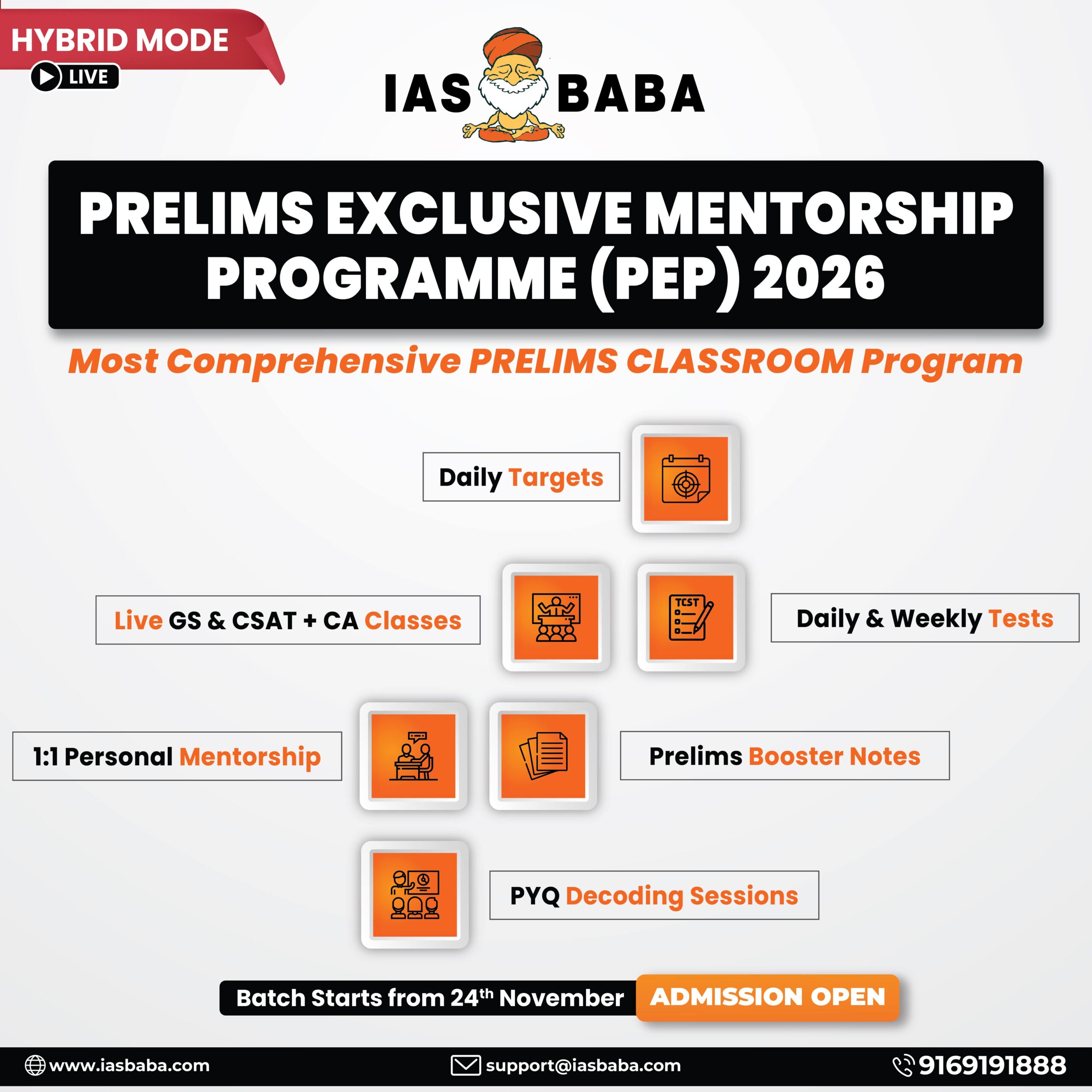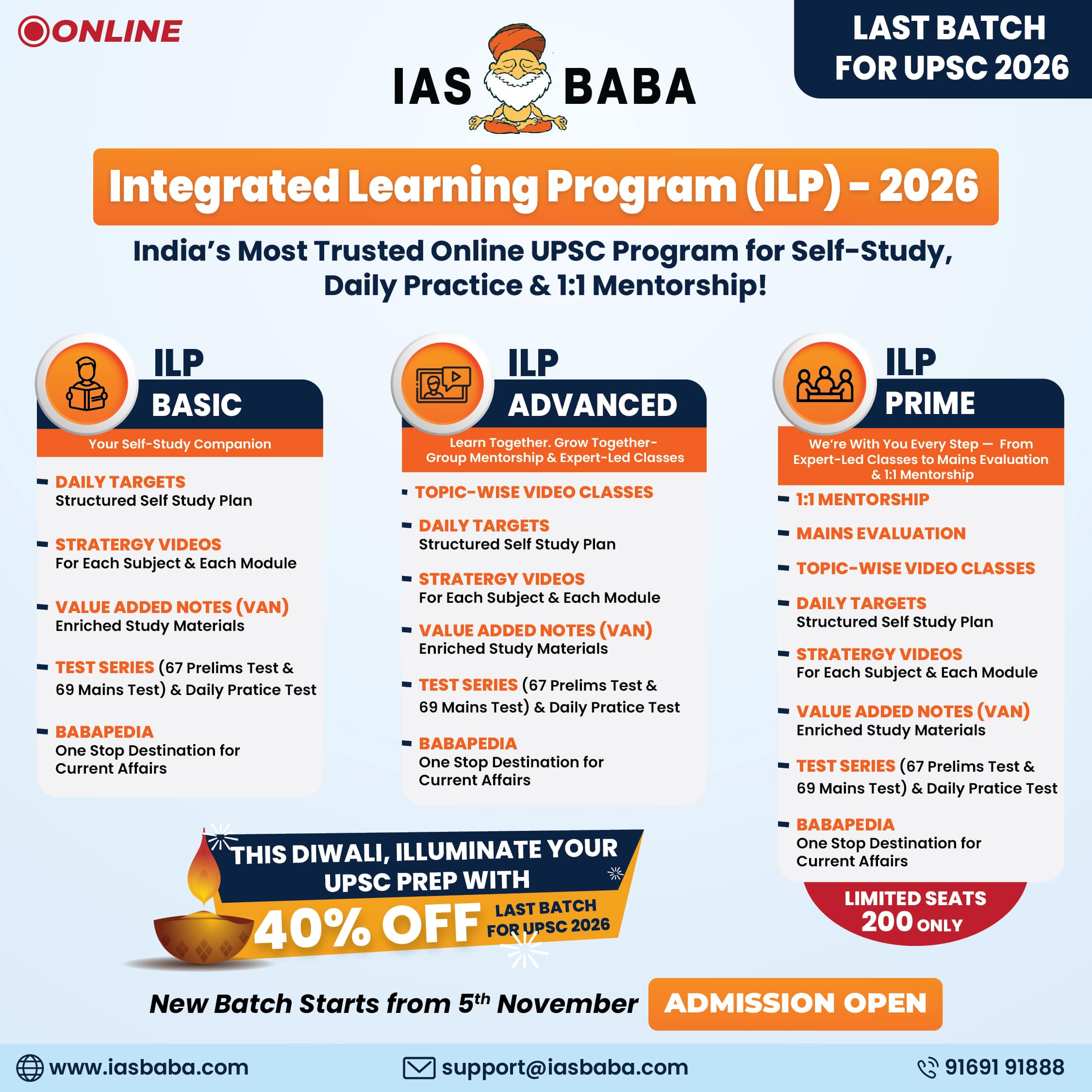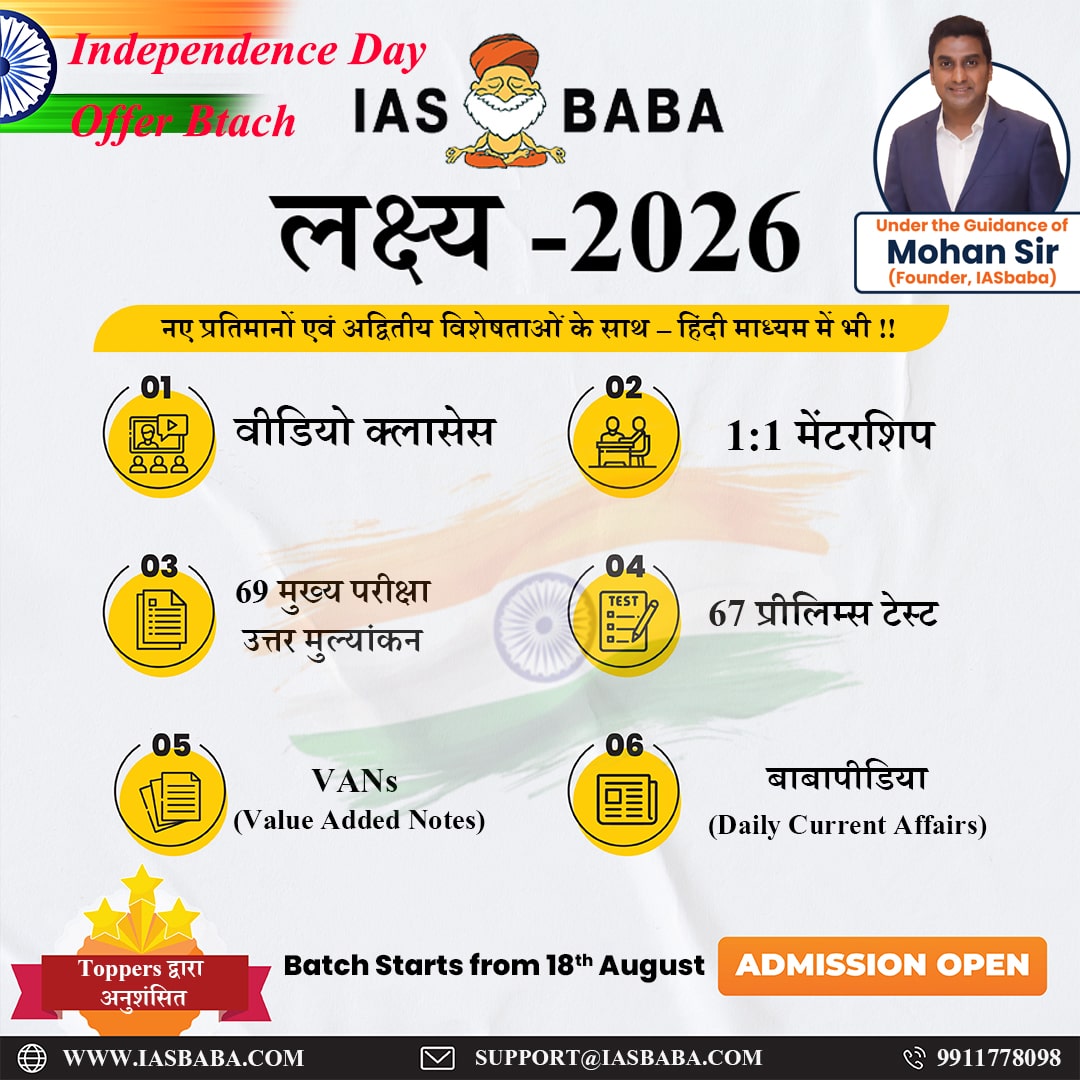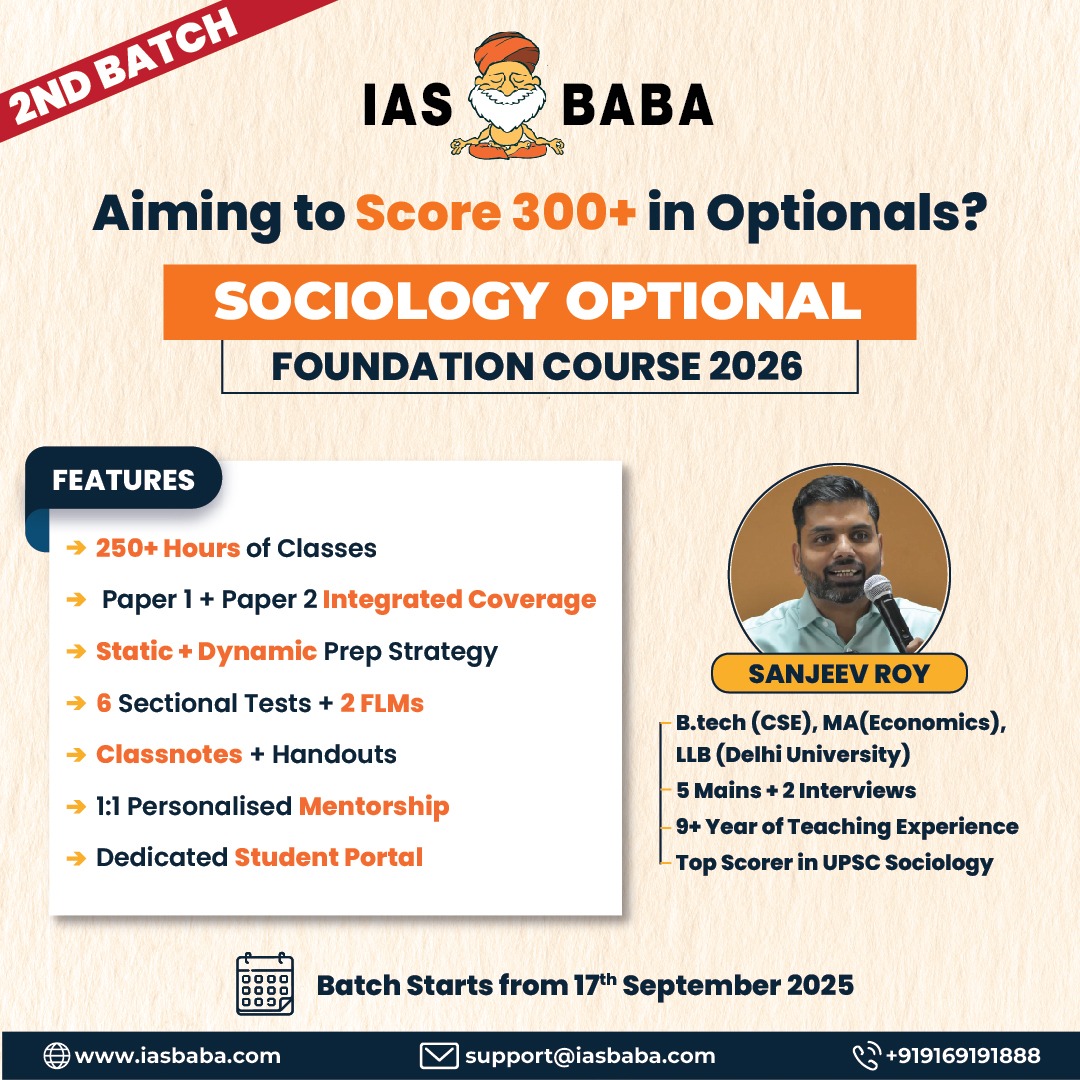IASbaba's Daily Current Affairs Analysis
Archives
(PRELIMS & MAINS Focus)
Syllabus:
- Prelims & Mains – CURRENT EVENT
Context: National Technical Textiles Mission completes 5 years.
Background: –
- With a view to boost technical textiles sector in the country, National Technical Textiles Mission (NTTM) was launched for a period from 2020-21 to 2025-26 with an outlay of Rs.1,480 crores.
Key takeaways
- The National Technical Textiles Mission (NTTM) is a flagship initiative by the Ministry of Textiles, Government of India, aimed at transforming and modernizing the country’s technical textiles sector.
- Technical textiles differ from traditional textiles in that they are developed to meet high-performance and specialized requirements across sectors such as agriculture, healthcare, construction, automotive, and defense.
- The mission was conceived with the key objective of positioning India as a global leader in technical textiles, leveraging its robust textile industry to create new economic opportunities, increase export potential, and drive technological innovation across diverse sectors.
Key Components of the Mission
- The NTTM is structured around four primary components, each targeting a crucial aspect of the sector’s growth:
- Research, Innovation, and Development (R&D)
- Objective: Stimulate innovation by supporting research projects that develop new materials, processes, and technologies.
- Initiatives: Funding for R&D projects which, to date, have reached a cumulative value of around ₹509 crores spread over 168 projects.
- Outcome: This drives the creation of advanced, high-performance textile products that meet demanding industry standards.
- Promotion and Market Development
- Objective: Enhance the market penetration of technical textiles both within India and internationally.
- Initiatives: Promotion campaigns, infrastructure development, and measures to create awareness among industrial users and consumers.
- Outcome: Increased adoption of technical textiles in key sectors, strengthening domestic use and global market recognition.
- Export Promotion
- Objective: Boost the export potential of India’s technical textiles by developing dedicated export strategies.
- Initiatives: Formation of an export council, participation in international trade fairs, and creating export-oriented policies tailored for this subsector.
- Outcome: Enhanced competitiveness and broader global reach for Indian manufacturers.
- Education, Training, and Skill Development
- Objective: Build a robust talent pool equipped with the specialized skills required for the technical textiles industry.
- Initiatives: Establishing training programs, internships, and academic programs in collaboration with top institutes and industries.
- Outcome: Empowering up to 50,000 individuals, ensuring that the workforce is ready to drive and sustain innovation in the field.
- Research, Innovation, and Development (R&D)
Source: PIB
Syllabus:
- Prelims & Mains – CURRENT EVENT
Context: A Parliamentary standing committee has recommended that a separate or a new law be enacted to grant CBI the power to investigate cases without needing consent from the state governments.
Background: –
- The department-related Parliamentary Standing Committee on Personnel, Public Grievances, Law and Justice in its demand for grants report noted that eight states have withdrawn general consent for CBI investigation.
Key takeaways
- The Committee notes that eight states have withdrawn general consent for CBI investigations limiting severely its ability to investigate corruption and organized crime.
- To address this problem, the Committee feels a separate/new law granting CBI wider investigative powers without state consent for cases affecting national security and integrity may be enacted by taking views also from State Governments.
- The eight states are Kerala, Punjab, Jharkhand, West Bengal, Telangana, Meghalaya, Karnataka, and Tamil Nadu. All of them are ruled by parties that are not part of the Bharatiya Janata Party-led National Democratic Alliance.
- Under Section 6 of the Delhi Special Police Establishment (DSPE) act , CBI needs the permission of state governments to investigate cases within those provinces, except in cases where orders are issued from the Supreme Court, high courts or Lokpal.
- The Parliamentary committee has also asked DOPT to introduced lateral entry for different units within CBI, after the agency informed about not receiving sufficient and suitable nominations of officers from state police, forces which has traditionally been a major source of induction.
- The committee said that shortage of suitable nominations for deputation to CBI was a serious concern ,as it affected the operational efficiency.
About CBI
- The Central Bureau of Investigation (CBI) is India’s premier investigative agency, functioning under the jurisdiction of the Department of Personnel and Training (DoPT), Ministry of Personnel, Public Grievances and Pensions.
- Established: 1941 as the Special Police Establishment (SPE).
- Renamed as CBI: 1963 by a resolution of the Ministry of Home Affairs.
- Legal Framework: Works under the Delhi Special Police Establishment (DSPE) Act, 1946.
- Director: Appointed by a committee comprising the Prime Minister, Chief Justice of India, and Leader of Opposition (LoP). The process of appointment was established by the Supreme Court’s Vineet Narain judgement (1997), and the changes made to The Delhi Special Police Establishment (DSPE) Act, 1946 by The Lokpal and Lokayuktas Act, 2013.
- Functions of CBI:
- Anti-Corruption Cases: Investigates corruption cases involving central government employees and PSUs.
- Economic Offenses: Handles bank frauds, financial scams, money laundering, cybercrime, etc.
- Special Crimes: Investigates serious crimes such as terrorism, organized crime, and drug trafficking.
- Suo Moto Jurisdiction: Can investigate only within Union Territories. In states, it requires the consent of the concerned State Government.
- High-Profile Cases: Can take over cases at the request of states or by Supreme Court/High Courts’ directives.
Source: Hindustan Times
Syllabus:
- Prelims – ENVIRONMENT
Context: Asian Development Bank (ADB) funded Solar park in Assam is accused of green grabbing.
Background:
- On March 26, the protestors belonging to various political formulations representing tribal bodies rallied against the Assam government’s plans to divert 18,000 bighas (2,396.5 ha) of tribal land to a solar power project supported by the Asian Development Bank (ADB).
Key takeaways
- Green Grabbing is a term used to describe the appropriation of land and natural resources by external entities—be they governments, corporations, or NGOs—in the name of environmental protection, conservation, or sustainable development.
- While environmental policies and projects are essential for stewarding natural resources, the process of green grabbing often masks deeper issues of power imbalance and the disenfranchisement of local communities.
- Green grabbing is essentially a subset of the broader phenomenon of land grabbing. However, unlike traditional land grabs driven mainly by agricultural or industrial interests, green grabbing is justified using environmental objectives.
Key Drivers and Mechanisms
- Environmental Rationale as a Pretext – Often, green grabbing takes place under the guise of:
- Biodiversity Conservation: Declaring areas as protected to conserve flora and fauna, which can lead to the exclusion of indigenous populations and local stakeholders.
- Climate Change Mitigation
- Ecotourism and Sustainable Development: Projects that promote ecotourism or “green” economic development may acquire land to create tourist attractions.
- Institutional and Policy Dynamics – Green grabbing is embedded in a complex network of policies, international negotiations, and financial mechanisms. Key mechanisms include:
- Carbon Markets: By placing a monetary value on carbon sequestration, governments and corporations can invest in forest projects in ways that might disenfranchise local communities.
- Public-Private Partnerships: Collaborations between state agencies and private firms sometimes redefine land ownership or usage rights, leading to shifts in control under the banner of environmental improvement.
- Legal Reforms: Changes in land-use laws or regulations can formalize processes that allow for the simplification of resource appropriation for “green” projects.
Socio-Economic Impacts
- Displacement of Local Communities – When land is reclassified for environmental conservation or commercial green initiatives, indigenous communities gets displaced.
- Loss of Traditional Rights: Communities that have managed and lived on these lands for generations may see their rights revoked or significantly restricted.
- Economic Marginalization: New regulatory frameworks or ownership models favor external investors or government agencies, which can disrupt local economies and traditional practices.
- Social Conflict: The ensuing struggle over land rights often triggers conflicts between local populations and external actors, exacerbating social and economic inequities .
Source: Down To Earth
Syllabus:
- Prelims & Mains – ENVIRONMENT
Context: The Tamil Nadu government has officially declared the Kasampatty (Veera Kovil) sacred grove in Dindigul district as a Biodiversity Heritage Site (BHS), making it the second such site in the state after Arittapatti in Madurai.
Background: –
- The Veera Kovil sacred grove has long been revered by local communities, who worship the deity ‘Veeranan’ at the temple within the grove. Beyond its spiritual significance, the grove plays a key role in climate regulation and biodiversity conservation.
Key takeaways
- A Biodiversity Heritage Site is a well-defined area—terrestrial, coastal, inland water, or marine—that meets one or more of the following criteria:
- Species Richness and Endemism: The area contains a large number of species, including many rare, threatened, or endemic species.
- Evolutionary Significance: It may host species or genetic traits that are unique, serving as reservoirs of evolutionary history.
- Cultural and Traditional Value: Many BHS are interwoven with cultural traditions and historical practices, where local communities have passed down traditional knowledge in managing ecological resources.
- Ecological Fragility: These sites often comprise ecosystems that are particularly sensitive to natural disturbances and external pressures.
- The concept of BHS is designed not to restrict traditional practices but to enhance conservation efforts and empower local communities by recognizing and supporting their role in stewardship of natural resources .
- Biodiversity Heritage Sites are notified by State Governments under Section 37 of the Biological Diversity Act, 2002.
- Examples of Biodiversity Heritage Sites in India:
- Nallur Tamarind Grove, Karnataka – One of the first BHS, with centuries-old tamarind trees.
- Gundia Region, Karnataka – Rich in endemic species of Western Ghats.
- Majuli Island, Assam – World’s largest river island with unique flora and fauna.
- Glory of Allapalli, Maharashtra – A conserved natural forest with diverse species.
- Arittapatti, Tamil Nadu – Notified in 2022, rich in biodiversity and historical significance.
Source: The News Minute
Syllabus:
- Prelims – SCIENCE & TECHNOLOGY
Context: NASA’s Parker Solar Probe has successfully completed its second close flyby of the sun.
Background: –
- The spacecraft swooped within 6.1 million kilometers of the sun’s surface at a whopping speed of 692,000 kilometers per hour.
Key takeaways
- The Parker Solar Probe (PSP) is a groundbreaking NASA mission designed to revolutionize our understanding of the Sun by venturing closer to it than any spacecraft before.
- Launched in 2018, the probe is part of NASA’s Living With a Star program and is built and managed by the Johns Hopkins University Applied Physics Laboratory.
Mission Objectives
- Mapping the Corona and Solar Wind: Parker’s primary objective is to investigate the physical processes in the solar corona. By entering the Sun’s outer atmosphere, the probe collects data on the temperature, magnetic fields, and plasma characteristics that drive the solar wind.
- Understanding Particle Acceleration: Studying how particles are accelerated to speeds of up to half the speed of light enhances the understanding of space weather—a phenomenon that can impact satellites, power grids, and communications on Earth.
- Unraveling the Mysteries of Solar Activity: By getting closer than ever to the Sun, scientists hope to answer longstanding questions about the mystery of coronal heating (why the corona is significantly hotter than the Sun’s surface) and the mechanisms behind solar flares and coronal mass ejections.
Key Technical Details
- Orbit and Proximity: Utilizing multiple gravity assists from Venus, the Parker Solar Probe’s elliptical orbit gradually reduces its perihelion (closest approach), allowing it to pass as near as approximately 6.1 million kilometers from the solar surface. This proximity is a record among human-made objects.
- Speed Records: At its closest approaches, the probe reaches staggering speeds of up to 692,000 kilometers per hour, making it the fastest human-made object in history. This record-breaking speed is essential for minimizing the time spent in the harshest sections of the corona while still gathering critical data.
Source: Space
Practice MCQs
Q1.) The term Green Grabbing refers to:
(A) A method of organic farming to enhance green cover.
(B) The use of renewable energy for industrial growth.
(C) The appropriation of land and natural resources in the name of environmental conservation.
(D) A strategy used to reforest degraded land.
Q2.) Which of the following is not a Biodiversity Heritage Site (BHS) in India?
(A) Majuli Island, Assam
(B) Arittapatti, Tamil Nadu
(C) Valley of Flowers, Uttarakhand
(D) Nallur Tamarind Grove, Karnataka
Q3.) The Parker Solar Probe, launched by NASA, is primarily designed to study:
(A) The possibility of human settlement on Mars
(B) The Earth’s magnetic field and its effects
(C) The Sun’s corona and solar wind
(D) The asteroid belt between Mars and Jupiter
Comment the answers to the above questions in the comment section below!!
ANSWERS FOR ’ Today’s – Daily Practice MCQs’ will be updated along with tomorrow’s Daily Current Affairs
ANSWERS FOR 28TH March – Daily Practice MCQs
Q.1) – b
Q.2) – a
Q.3) – b













